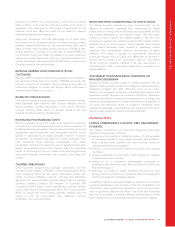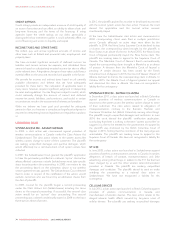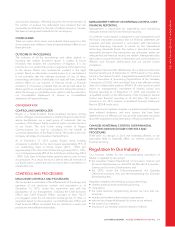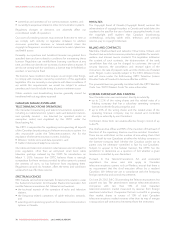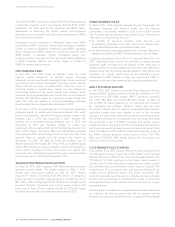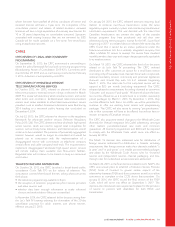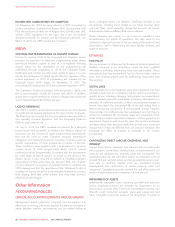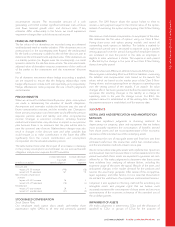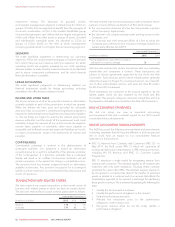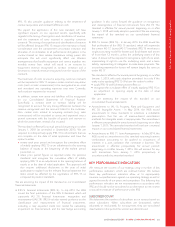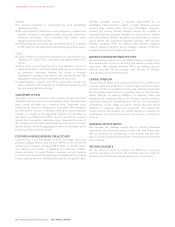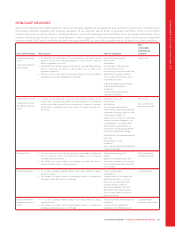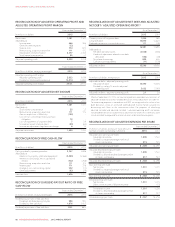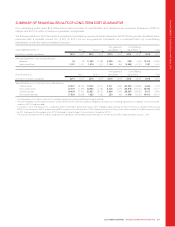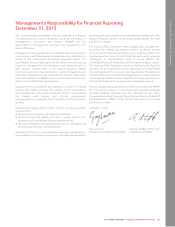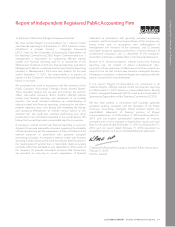Rogers 2015 Annual Report Download - page 84
Download and view the complete annual report
Please find page 84 of the 2015 Rogers annual report below. You can navigate through the pages in the report by either clicking on the pages listed below, or by using the keyword search tool below to find specific information within the annual report.
MANAGEMENT’S DISCUSSION AND ANALYSIS
impairment testing. The allocation of goodwill involves
considerable management judgment in determining the CGUs (or
groups of CGUs) that are expected to benefit from the synergies of
a business combination. A CGU is the smallest identifiable group
of assets that generates cash inflows that are largely independent
of the cash inflows from other assets or groups of assets. Goodwill
and indefinite-life intangible assets are allocated to CGUs (or
groups of CGUs) based on the level at which management
monitors goodwill, which is not higher than an operating segment.
SEGMENTS
We make significant judgments in determining our operating
segments. These are components that engage in business activities
from which they may earn revenue and incur expenses, for which
operating results are regularly reviewed by our chief operating
decision makers to make decisions about resources to be allocated
and to assess component performance, and for which discrete
financial information is available.
HEDGE ACCOUNTING
We make significant judgments in determining whether our
financial instruments qualify for hedge accounting, including
assumptions for effectiveness valuation models.
INCOME AND OTHER TAXES
We accrue income and other tax provisions based on information
currently available in each of the jurisdictions in which we operate.
While we believe we have paid and provided for adequate
amounts of tax, our business is complex and significant judgment is
required in interpreting how tax legislation and regulations apply to
us. Our tax filings are subject to audit by the relevant government
revenue authorities and the results of the government audit could
materially change the amount of our actual income tax expense,
income taxes payable or receivable, other taxes payable or
receivable, and deferred income tax assets and liabilities and could,
in certain circumstances, result in the assessment of interest and
penalties.
CONTINGENCIES
Considerable judgment is involved in the determination of
contingent liabilities. Our judgment is based on information
currently known to us, and the probability of the ultimate resolution
of the contingencies. If it becomes probable that a contingent
liability will result in an outflow of economic resources, we will
record a provision in the period the change in probability occurs.
The amount of the loss involves judgment based on information
available at that time. Any provision recognized for a contingent
liability could be material to our consolidated financial position and
results of operations.
TRANSACTIONS WITH RELATED PARTIES
We have entered into certain transactions in the normal course of
business with related parties in which we have an equity interest.
The amounts received from or paid to these parties were as follows:
Years ended December 31
(In millions of dollars) 2015 2014 % Chg
Revenue 115 15 n/m
Purchases 170 88 93
We have entered into business transactions with companies whose
partners or senior officers are Directors of RCI, which include:
• the non-executive chairman of a law firm that provides a portion
of the Company’s legal services;
• the chairman of a company that provides printing services to the
Company; and
• the chairman and chief executive officer of a firm to which the
Company pays commissions for insurance coverage (ceased as a
related party effective April 2015).
Years ended December 31
(In millions of dollars) 2015 2014
Printing, legal services, and commission paid on
premiums for insurance coverage 31 38
We have also entered into certain transactions with our controlling
shareholder and companies it controls. These transactions are
subject to formal agreements approved by the Audit and Risk
Committee. Total amounts paid to these related parties generally
reflect the charges to Rogers for occasional business use of aircraft,
net of other administrative services, and were less than $1 million
for 2015 and 2014 combined.
These transactions are measured at the amount agreed to by the
related parties, which are also reviewed by the Audit and Risk
Committee. The amounts owing are unsecured, interest-free, and due
for payment in cash within one month from the date of the transaction.
NEW ACCOUNTING STANDARDS
We did not adopt any new or amended accounting
pronouncements that had a material impact on our 2015 annual
consolidated financial statements.
RECENT ACCOUNTING PRONOUNCEMENTS
The IASB has issued the following new standards and amendments
to existing standards that will become effective in a future year and
will or could have an impact on our consolidated financial
statements in future periods.
• IFRS 15, Revenue from Contracts with Customers (IFRS 15) - In
May 2014, the IASB issued IFRS 15 which will supersede all
existing standards and interpretations in IFRS relating to revenue,
including IAS 18, Revenue and IFRIC 13, Customer Loyalty
Programmes.
IFRS 15 introduces a single model for recognizing revenue from
contracts with customers. This standard applies to all contracts with
customers, with only some exceptions, including certain contracts
accounted for under other IFRSs. The standard requires revenue to
be recognized in a manner that depicts the transfer of promised
goods or services to a customer and at an amount that reflects the
consideration expected to be received in exchange for transferring
those goods or services. This is achieved by applying the following five
steps:
1. Identify the contract with a customer;
2. Identify the performance obligations in the contract;
3. Determine the transaction price;
4. Allocate the transaction price to the performance
obligations in the contract; and
5. Recognize revenue when (or as) the entity satisfies a
performance obligation.
82 ROGERS COMMUNICATIONS INC. 2015 ANNUAL REPORT



